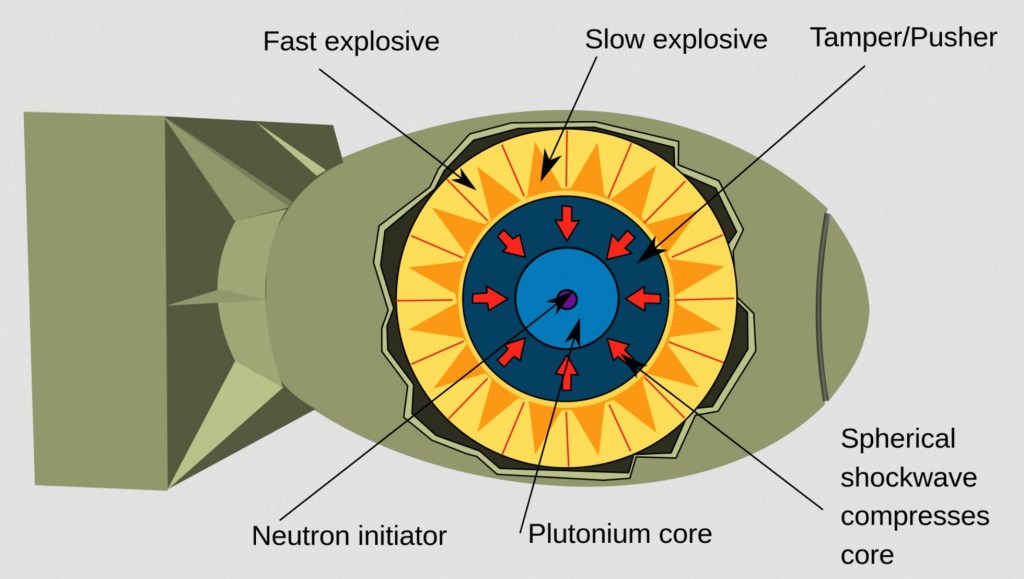Why is the US ramping up production of plutonium ‘pits’ for nuclear weapons?

The Pentagon is concerned about the the US nuclear arsenal’s viability, but critics worry about a renewed arms race
Guardian, Edward Helmore, 26 Nov 23
On one side of the US – on New York’s Staten Island – the US army corps of engineers began this month to remove the radioactive remnants of Robert Oppenheimer’s Manhattan Project that produced the atomic bombs that ended the second world war.
Meanwhile, 2,000 miles away, at the Los Alamos national laboratory north of Santa Fe in New Mexico, on the same site that developed and assembled the bombs dropped on Hiroshima and Nagasaki, work is being ramped up to produce plutonium “pits” – spherical shells about the size of bowling balls that are a vital component of warheads in the US nuclear arsenal.
Both in their own way tell the story of the nuclear age, but one is historic housekeeping – in 1939, 1,200 tons of high-grade uranium ore was purchased and transferred from the Belgian Congo to Staten Island, where there are still traces of radioactive contamination – and the other is far more controversial and very current.
Both arrive as concern over a conflict involving the use of nuclear weapons rises.
Increasing geopolitical tensions with Russia and a militarily expansionist China are behind a $1.5tn US effort to modernize the US nuclear arsenal, including tens of billions of dollars to replace aging, silo-launched Minuteman intercontinental ballistic missiles stationed in Wyoming, Montana and North Dakota with a successor, the Sentinel.
But the prospect of placing new missiles, with potentially more warheads, in the US heartlands is under scrutiny for its logic. “Why plant a $100-billion nuclear ‘kick me’ sign on the country’s breadbasket?” asked the authors of a report in Scientific American this month.
For two decades, the Pentagon and Congress have been concerned about the US ability to produce the cores of nuclear warheads, including the plutonium pits. Since 1989, the US has not been able to produce pits in quantities required to refresh or renew a stockpile of 3,708 warheads (about 1,770 warheads are deployed and 1,938 are held in reserve).
The issue is that plutonium degrades over time, but estimates vary on how quickly or at what point the pits become too soft to be usable. Most are already 40-plus years old, but some studies say they could be good up to 80 years. The Livermore lab in northern California announced in 2012 that it had found “no unexpected aging issues … in plutonium that has been accelerated to an equivalent of ~150 years of age”……………………………………………………………………..
In September, the UN secretary-general, António Guterres, warned that a “worrisome new arms race is brewing. The number of nuclear weapons could rise for the first time in decades.” Over the summer, a biopic of Robert Oppenheimer was released that touched on anxieties the physicist experienced over the development of the nuclear bomb and its use on Japan.
Those anxieties resurfaced in a recent weeks when a since-reprimanded Israeli minister speculated on dropping a nuclear bomb on Gaza, and the deployment of an 18,000-ton Ohio-class nuclear submarine to the Mediterranean.
Last week, Green party presidential hopeful Jill Stein warned that US leaders are “absolutely” risking the possibility of nuclear war in its support of Israel after sending the sub and missile groups to the region. “We’re not at nuclear war now, but could a nuclear war be triggered? Absolutely. And we’re seeing this become more dangerous every day,” Stein told Newsweek…………………………………………………..more https://www.theguardian.com/world/2023/nov/26/us-nuclear-arsenal-plutonium-pits
No comments yet.
-
Archives
- May 2024 (212)
- April 2024 (366)
- March 2024 (335)
- February 2024 (345)
- January 2024 (375)
- December 2023 (333)
- November 2023 (342)
- October 2023 (366)
- September 2023 (353)
- August 2023 (356)
- July 2023 (362)
- June 2023 (324)
-
Categories
- 1
- 1 NUCLEAR ISSUES
- business and costs
- climate change
- culture and arts
- ENERGY
- environment
- health
- history
- indigenous issues
- Legal
- marketing of nuclear
- media
- opposition to nuclear
- PERSONAL STORIES
- politics
- politics international
- Religion and ethics
- safety
- secrets,lies and civil liberties
- spinbuster
- technology
- Uranium
- wastes
- weapons and war
- Women
- 2 WORLD
- ACTION
- AFRICA
- Atrocities
- AUSTRALIA
- Christina's notes
- Christina's themes
- culture and arts
- Fuk 2022
- Fuk 2023
- Fukushima 2017
- Fukushima 2018
- fukushima 2019
- Fukushima 2020
- Fukushima 2021
- general
- global warming
- Humour (God we need it)
- Nuclear
- RARE EARTHS
- Reference
- resources – print
- Resources -audiovicual
- World
- World Nuclear
- YouTube
-
RSS
Entries RSS
Comments RSS


Leave a comment